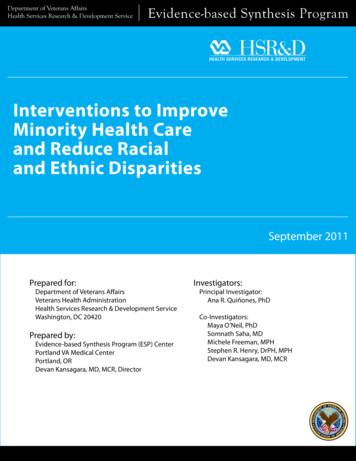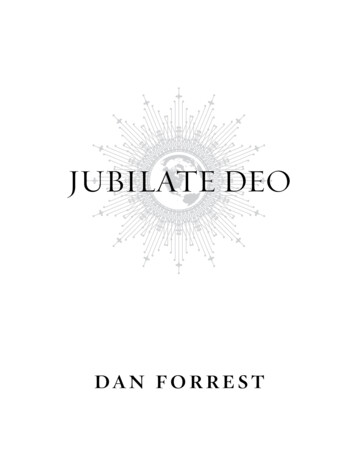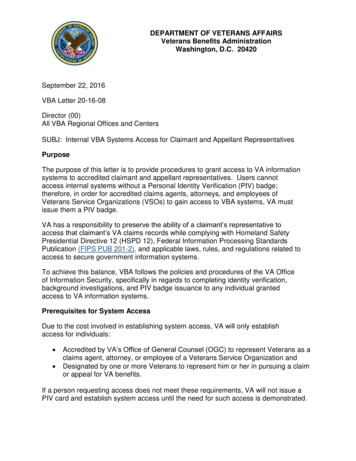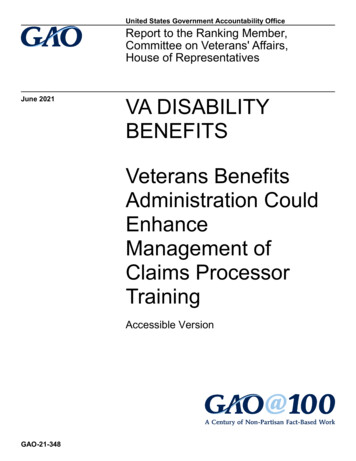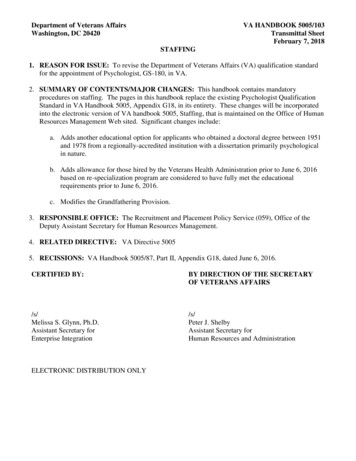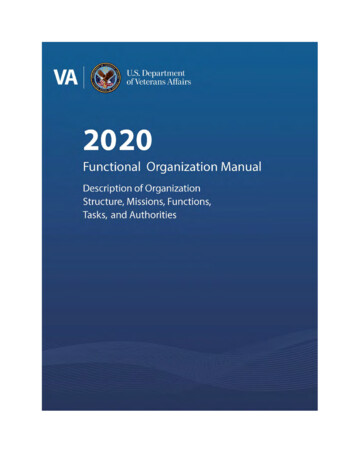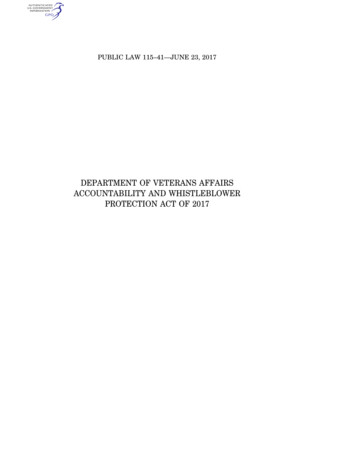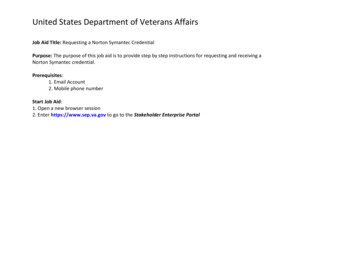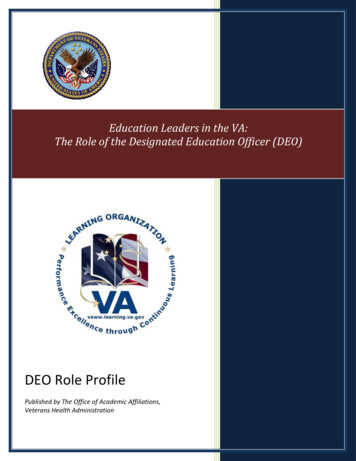
Transcription
Education Leaders in the VA:The Role of the Designated Education Officer (DEO)DEO Role ProfilePublished by The Office of Academic Affiliations,Veterans Health Administration1
Introduction and BackgroundPrior to 1994, education leadership positons were centralized and “vetted” through the Veteran’s HealthAdministration (VHA) Office of Academic Affiliations (OAA). With reorganization to Veterans IntegratedService Networks (VISNS), education leadership positions were decentralized and facilities had varying waysof ensuring adequate leadership at the local level for staff and health professions trainees. By the early2000’s, nearly 60 education titles existed for these roles. To ensure adequate leadership at the local level,meet various program accreditation standards, and begin to define oversight responsibilities for healthprofessions trainees the concept of a Designated Education Officer (DEO) was established. The DEO isresponsible for ensuring the administration and oversight of clinical trainee programs at VA Medical Centers.In some facilities the DEO may be called the Associate Chief of Staff for Education (ACOS/E). Administrationand oversight of staff learning needs are conducted by a Designated Learning Officer (DLO) or Chief LearningOfficer. Some facilities have the ACOS/E serve as both the DEO and DLO depending on size and complexity.In this context in November of 2007, VHA endorsed a long-term transformational performance goal to“distinguish VHA as a Learning Organization.” The goal is aimed at transitioning VHA from the prior state oftraditional, mandatory and compliance driven education to one that integrates learning into the work of theorganization and drives performance.Learning organizations are effective organizations because they: Foster innovationIncrease the ability of the organization to manage changeImprove quality and performanceIncrease employee satisfactionImprove retentionDevelop a more committed and engaged workforceLearning Leader Competency ProjectThe T-4 transformational goal (2011) prompted the need to create a new profile for Learning Leaders acrossVHA. The role of learning leaders, including the Designated Learning Officer (DLO) and the DesignatedEducation Officer (DEO), is critical to supporting the mission of the VA.DEO Role Description:The Designated Education Officer (DEO) or Associate Chief of Staff for Education (ACOS/E) is a facility-basedlearning leader with oversight, responsibility, and accountability for all accredited and affiliated clinicaltrainee programs within that facility. The DEO maintains the quality of the relationships with affiliates and apositive, effective local learning environment. Thus, the DEO contributes to the quality of health care forVeterans and the nation.2
DEO Role DescriptionAdditional DEO Role Background: VA has the statutory mission to provide health professions education, resulting in beneficial outcomesfor Veterans, trainees, VA, and the nation. Excellent health professions training results in thedevelopment of future health professionals who are well prepared to care for Veterans, enhances VA’sown recruitment and retention of highly qualified staff, and creates an environment of teaching,learning and inquiry that fosters the delivery of high quality, evidence-based care. Over the past 10years, the training mission in VA has become more complex and has attracted increasing scrutiny fromexternal entities, such as Office of Inspector General (OIG), Government Accounting Office (GAO) andothers. To ensure the highest quality education, to provide strong oversight of educational processes,and to guide the relationship between the facility’s training goals with other operational issues, eachfacility must provide for the creation of a facility-based education leader known as the DesignatedEducation Officer (DEO). The title of DEO was first written into VA policy on resident supervision in 2005, in order to provide auniform focal point and point of contact for responsibility for management of certain aspects ofmanagement of affiliated training programs. The DEO operates with a functional description similar tothat used by Accreditation Council for Graduate Medical Education (ACGME), where each institutionsponsoring physician resident programs is required to have a Designated Institutional Official (or “DIO”).DEO is a functional title, not an organizational title. In VA complexity level 1 and 2 facilities, thepreferred organizational title is Associate Chief of Staff for Education (ACOS/E) or similar designationto reflect the key organizational role of this individual. Other possible titles include the Director ofEducation, Chief Education Officer, or Chief, Education Office. Facilities take into account local needs,staffing, and number of trainees when determining if it is necessary to have both a DEO (oversight oftrainee education) and DLO (oversight of staff education and workforce development). In many facilities,the role of DEO is only one of the several roles the Associate Chief of Staff for Education may perform.In some instances (e.g. smaller facilities) the DEO may serve also as the DLO. Office of Academic Affiliations (OAA): OAA supports the statutory mission of “health professionseducation for VA and the Nation”. OAA oversees the strategies, policies, and procedures that supportover 125,000 trainees receiving clinical training in the system every year and provides policy anddirection for issues pertaining to affiliation relationships, trainee functions and accreditation, stipendmanagement, and trainee supervision. DEOs serve as OAA’s primary point of contact at the facility leveland focal point for communication of initiatives, issues, and policy from VHA/OAA. The DEO should regularly assess educational resources at the local facility and advocate for appropriateresources. At the local level (including parent and outpatient facilities), ensuring trainees are properly appointed,evaluated, trained, and appropriately supervised are primary DEO responsibilities. The DEO should befamiliar with relevant education Directives/Handbooks (1400 series and other Human Resources policy),participate in national and VISN education calls, and attend OAA sponsored educational conferences and3
trainings. In conjunction with other local leaders, the DEO oversees relationships with a wide variety ofprofessional schools, such as medical schools, dental schools and nursing schools, and participate inGME committees at their major affiliates. Participation in the local management of trainee funding isanother vital function, which includes oversight of the administration of trainee stipends, residentactivity reporting, affiliation agreements, educational cost contracts, resident rate schedules, programletters of agreement, and disbursement agreements. The DEO is expected to update these documentsaccording to OAA Directives/Handbooks. The DEO plays an integral role in maintaining long standing affiliate relationships but also evaluating thevalue for new partnerships to ensure a workforce able to address the needs for veterans for years tocome. These relationships may include partnering with Department of Defense (DoD) trainingprograms. The DEO should play a key role in partnering with affiliates such as working on joint recruiting, assuringVA clinicians have faculty appointments, and actively building relationships through AffiliationPartnership Councils. In 2014 through the Veterans Access, Choice, and Accountability Act, (VACAA), legislation was passed toenhance Graduate Medical Education (GME) for physician trainees. This legislation focused onenhancing VA training in the areas of Primary Care, Mental Health, and “Critical Needs” by increasingGME positions by 1500 by 2025. In addition, underserved and rural areas are areas of focus for theexpansion. The DEO plays a significant role enhancing the VACAA initiative at their local level. DEOs should be monitoring faculty evaluations, the learning environment and assessing educationalresources on an annual basis. DEOs also act as educational consultants on matters pertaining to affiliations and accredited trainingprograms, especially regarding the initiation of new affiliations, programs, and sites of training. DEOs are important participants in VA system redesign efforts, as health professions trainees are vitalparticipants in a wide variety of clinical activities. The interaction of trainee activities and clinicalactivities must be considered when changes to either are being considered, as mutual benefit should besought and unanticipated adverse consequences to either should be avoided. While overall objectives are similar and a close working relationship (if not consolidated in one position)is expected, the DEO and DLO roles may be differentiated as follows (see summary table below):o The DLO is primarily concerned with VA staff education and workforce development.o The DEO is primarily concerned with affiliated, accredited training programs, affiliations andaffiliation agreements, and interface with academic counterparts at affiliates.o Both are expected to have good working relationships with Human Resources Managementand Fiscal Services as well as all service chiefs. In addition, the DEO should be incommunication with the ACOS/Research.o The DEO must report to the Chief of Staff (COS), but the lines of reporting for the DLO havebeen variable.4
ooThe principal VACO interface for DEOs is the Office of Academic Affiliations (OAA); whereas,the principal VACO interfaces for DLOs are the Employee Education System (EES) andNational Center for Organization Development (NCOD).Both the DEO and DLO are expected to be Learning Leaders and should be consulted by staffand VA facility leadership on matters pertaining to their respective areas of expertise.Role ComparisonCategory/AttributePrimary focusLocal interfaceVISN interfaceVACO lificationsLines of reportingDEODLOAffiliated training programs,affiliations, VA training programs &academic relationships, DoDHR, Fiscal, all service chiefs,ACOS/R&D, COSNetwork Academic AffiliationsOfficer (NAAO)VA staff education, workforcedevelopment, and successionplanning, DoDHR, Fiscal, all service chiefs, COS,ADOffice of Academic Affiliations(OAA)As an educational leader,pertaining to academic programsClinical education & training,accreditation standards, affiliationsand related agreements, traininginnovationsDoctorally-prepared clinician oreducator; experience in clinicaleducation management &affiliations; has a facultyappointmentChief of Staff (per policy)Network DLOEmployee Education Sys (EES), &Nat’l Center for OrganizationDevelopment (NCOD)As an educational leader,pertaining to staff developmentAdult education and learningtechnologies, continuing clinicaleducation & standardsMasters or doctorally-preparedclinician or educator, withexperience in educationmanagementVariable (e.g., ACOS/E, COS, AD,Director, HR)5
Learning Leader: 4 “Areas of Expertise”The functional role of the Learning or Education Leader was identified through a recent series of focusgroups. 4 Areas of Expertise were identified for learning leaders to ensure the transformation to a learningorganization. It is suggested that all supportive learning roles (DLO, DEO, Ed. Coordinator, etc.) be alignedwith these areas of expertise.Learning/Education Leader4 Areas of ExpertiseEnabling LearningAligning ResourcesDescription Creates and sustains an organizational work environmentthat supports learning, discovery, and continuousimprovement. Aligns and manages fiscal, human and capital resources tomeet organizational learning needs.Driving Results Drives learning and performance results to impactorganizational success.Leading Change Leads organizational change and transformation throughpositioning and implementing innovative learning andeducation strategies.6
DEO Role – Expertise in “Enabling Learning”DEO responsibilities that align with this Education/Learning Leader Area of Expertise The DEO provides leadership and collaboration in developing and deploying educational and trainingprograms, resources, and services to execute the organization’s strategy through planning,organizing, monitoring, and adjusting activities associated with accredited trainees’ VA experiences.The DEO uses historical, current, and emerging organization priorities to forecast, plan, and guideday-to-day education activities to achieve desired results and establish planning continuity betweenthe organization and affiliates.The DEO interacts with local VA management and service-level managers to ensure the VAeducation environment supports the curricular needs of trainees as well as the care needs ofVeterans.The DEO establishes working relationships with affiliates and manages affiliate relationships in orderto:o Advance the VA strategy and the educational needs of affiliates.o Resolve issues in a constructive and collaborative manner within the VA and with affiliates.DEO Task and Behavioral Descriptions of Responsibility Serves as the VA point of contact (POC) for all issues involving trainees in accredited programs. Initiates and conducts the planning process to determine the number and distribution of residentpositions. Ensures appropriate establishment and execution of affiliation agreements, disbursementagreements, MOUs, and program letters of agreement (PLAs). In addition, the DEO ensuresappropriate processes are in place to keep these documents stored and updated as perrequirements. Provides oversight (consistent with VA policy and accreditation requirements) of all traineesincluding graduate medical, dental education, nursing and other associated health trainees at the VAfacility or consolidated facilities using appropriate Directives and Handbooks. Completes required facility, VISN, and VHA OAA reports. Demonstrates background and knowledge of educational programs and adult “learning” to workwith program directors and clinical staff to ensure that appropriate clinical training environments,and adequate clinical workload are available to meet educational objectives. Manages educational affiliations and all appropriate agreements for the affiliation. Ensures that all residents and trainees have appropriate VA appointments through the HumanResources Service, have facility and badge access, and remain up to date on any mandatory training. Ensures that formal affiliation agreements, Trainee Qualification and Verification Letters (TQCVLS),disbursement agreements, and Program letters of agreements (PLAs), and Memorandums ofUnderstandings (MOUs) are in place for all sponsoring institutions as needed.7
Is familiar with the VA policies impacting trainee education and accreditation requirements ofvarious programs.Oversees trainee education monitors – e.g., resident supervision, resident time keeping, etc.Has an understanding of legal issues affecting trainees (e.g., tort claims).Interfaces with affiliate DIO, Associate Deans (for Undergraduate, Graduate, and Continuing MedicalEducation), Deans of Nursing and Pharmacy and clinical department chairs.Participates on key educational committees at the affiliate (e.g., the Graduate Medical EducationCommittee).Participates in national calls and conferences sponsored by OAA.Works closely with hospital leadership and affiliates to educate and appoint site directors for theeducational programs and assist with advocating for joint faculty appointments and recruitment.DEO Role – Expertise in “Aligning Resources”DEO Responsibilities that align with this Education/Learning Leader Area of Expertise1. Education Fiscal Stewardship: Manages Affiliation Funding and Payment fiscal resources to supportdeployment of trainee education services.DEO Task and Behavioral Descriptions of Responsibility Manages distributed funds to facilities to pay stipends to trainees. Oversees and manages appropriated disbursement agreement funds at each facility in accordancewith the VHA HANDBOOK 1400.05. Ensures obligations are met by academic affiliates (i.e. tracking of the “agreements” and followingpolicies). Oversees the appointment and direct payment of trainees. Applies pertinent OAA and HRpolicy/guidance as it relates to affiliation funding. Advocates for trainee experiences and rotations that support the care needs of Veterans. Negotiates with educational institutions for a trainee mix that will support specific programs andVeteran services.2. Education Resources Infrastructure Management: Ensures the necessary mix of resources [i.e.program, human, capital and technology] are available to support the oversight of disbursementagreements.DEO Task and Behavioral Descriptions of Responsibility Provides leadership in designing and implementing trainee education solutions to meet the needs ofthe organization and the trainee. Oversees educational activity record keeping for affiliate training at the VA.8
Monitors trainee and resident participation in assigned educational activities and clinicalassignments (e.g. Ensuring trainees have completed the Mandatory Training for Trainees Course orRefresher annually).Assigns staff to support key trainee requirements such as trainee appointments, backgroundscreening, orientation, etc.Collaborates with other services to coordinate key trainee functions such as assigning parking,assigning computer codes, giving remote access into the medical record (VPN accounts), ID creation,etc.DEO Role – Expertise in “Driving Results”DEO Responsibilities that align with this Learning Leader Area of Expertise1. Oversight of Trainee Programs: Provides education expertise, advice, guidance and problem-solving toidentify and understand trainee needs, problems and opportunities. Specifically, uses data andinformation collected from monitors, audits, QM, risk management activities, and surveys to drivefacility-wide improvements through use of educational methods.2. Enhancement of Performance Improvement: Uses knowledge of training programs and participation inappropriate facility and VISN committees to identify areas in need of improvement at the facility andVISN level and to suggest appropriate methods of addressing them.DEO Task and Behavioral Descriptions of Responsibility Provides oversight to ensure trainees have proper clinical supervision in place and are monitoredaccordingly to required guidelines. Encourages participation in VA’s Learners’ Perceptions Survey to ensure a locally high response rate. Use Learners’ Perceptions Survey (LPS) data to monitor the effectiveness of trainee educationprograms and as a quality improvement tool. Monitors documentation of resident supervision in health record to ensure that supervision isoccurring according to policy and in a manner conducive to high quality, safe patient care. Monitor quality of supervision to ensure supervising clinicians are providing guidance, coaching andmentoring. Review risk events (‘near misses’, adverse events, patient complaints and tort claims) for residentinvolvement and appropriate supervision. Collaborate with or give feedback to service chiefs and/or chief of staff when deficiencies areoccurring or gaps are present in supervision. Participate in evaluation of innovative or pilot educational projects that involve trainees.9
DEO Role – Expertise in “Leading Change”DEO Responsibilities that align with this Learning Leader Area of ExpertiseEducation/Learning Leadership: Communicates and translates a learning organization vision into action and promotes practices thatsupport a positive and effective trainee education experience in conjunction with the provision ofoutstanding health care. Remains abreast of developments in the field of graduate medical and dental education in order torecognize and promote innovative practices.DEO Task and Behavioral Descriptions of Responsibility: The DEO Proposes continuous process changes and innovation in of trainee educational programs. Implements educational programs that are respectful of generational differences of trainees (anddifferences in preferences such as “work/life balance,” etc.). Serves as a primary consultant on trainee educational matters to VA staff and managers Participates in strategic planning at VA facility and Network level. Facilitates communication and provides guidance and support to facility and affiliate leaders todevelop or expand programs in response to VA Requests for Proposals (RFP’s) and other initiatives. Actively participates in starting new training programs or initiatives, especially those involving qualityand patient safety such as the Chief Residents in Quality and Patient Safety. Advocates for changes in education focus as new trainees demand new technologies and newlearning methodologies. Advocates for change in education curriculum and structure based upon educational research and tobetter trainees for the practice environments of the future. Promotes inter-professional educational models. Is familiar with the education literature and educational research. Annually, engages in continuing education aimed at enhancing one’s professional development (e.g.,the American Association of Medical Colleges Group on Resident Affairs (AAMC-GRA) spring meetingand their course for GME Leadership). Manages the complex and high level relationships between VA and academic affiliates. Integrates successfully into high level leadership forums and meetings by establishing credibility andexpertise in the education arena. Advocates successfully for both VA and affiliate interests (depending on audience) and translateseffectively between cultures. Conducts research on education and presents findings at regional or national meetings citing the VA. Publishes on educational research and topics in peer-reviewed journals and other publications citingthe VA (e.g., society newsletters).10
DEO roles & expertise – analogy to Maslow’s Hierarchy of NeedsMaking a real difference –transformational role of theeducation/learning leaderLeadingChangeMoving forward – using data toproduce facility-wide improvementsDriving ResultsMeeting basic policy,regulatory, financial, andaccreditation requirementsAligning Resources & EnablingLearningDEO QualificationsA DEO should ideally be a senior, doctorally-prepared clinician (medicine, nursing, or other associated healthleader) and a respected educator experienced in the administration of educational programs andknowledgeable about affiliations and affiliation relationships. For programs with large Graduate MedicalEducation Programs, experience with GME is highly recommended to ensure compliance with accreditationstandards and VA policy. A doctorally-prepared educator with experience in CLINICAL education andacademic medical education settings would also be acceptable. Familiarity with graduate medical educationand other health professions education is essential. The appointment process should be a sharedresponsibility of the facility Chief of Staff, the VISN CMO or Network Director, and the Office of AcademicAffiliations (OAA). The VACO Chief Academic Affiliations Officer could be consulted early in the recruitmentprocess regarding the selection of the candidate. If an individual nominated for the position by the facilityor VISN is not thought to meet basic qualifications or is predicted to not be successful in the DEO role, theOffice of Academic Affiliations will discuss alternatives to the nominated candidate or suggest remediationstrategies with the facility or VISN leadership. OAA will help ensure the placement of all new DEOs in anappropriate professional development program and will assist with the identification of appropriatementors and preceptors. A DEO should have (or qualify for) an appropriate faculty appointment in thedepartment most relevant to his/her expertise. Ideally, a DEO would also have management experience asa service or section chief or as a program director.11
Education/Training ExpectationsWithin one year of appointment, the DEO should participate in the OAA-sponsored training for DEOs. AllDEOs should participate in national conferences sponsored by OAA. In addition, it is strongly encouragedthat a new DEO attend the three-part AAMC Group on Resident Affairs (GRA, Association of AmericanMedical Colleges) course on GME Leadership and the annual AAMC GRA spring meeting.Time/Effort Commitment to the DEO RoleFor DEOs in facilities with 100 or more residents, the DEO should devote between 50 to 100% of his/hertime/effort to the DEO role (not taking into account collateral any possible DLO collateral duties). If lessthan 100 residents, between 20 to 50% time/effort would be appropriate, depending upon the number ofresidents, number of associated health trainees, and the complexity of the affiliation relationships. Havingappropriate educational resources (including support staff and space) for education and DEO are necessaryto ensure the success of the training programs. Hospitals are encouraged to use educational funds (indirectVERA funding for trainees) to offset these expenses. If there are a large number of additional trainees (e.g.Associated Health, Students), additional staffing may be required. Office staffing should be commensuratewith the size and complexity of the training programs and affiliation relationships. Administrative staffsupporting the education office are also invited and encouraged to attend OAA-sponsored trainings.12
The functional role of the Learning or Education Leader was identified through a recent series of focus groups. 4 Areas of Expertise were identified for learning leaders to ensure the transformation to a learning organization. It is suggested that all supportive learning roles (DLO, DEO, Ed. Coordinator, etc.) be aligned with these areas of .

